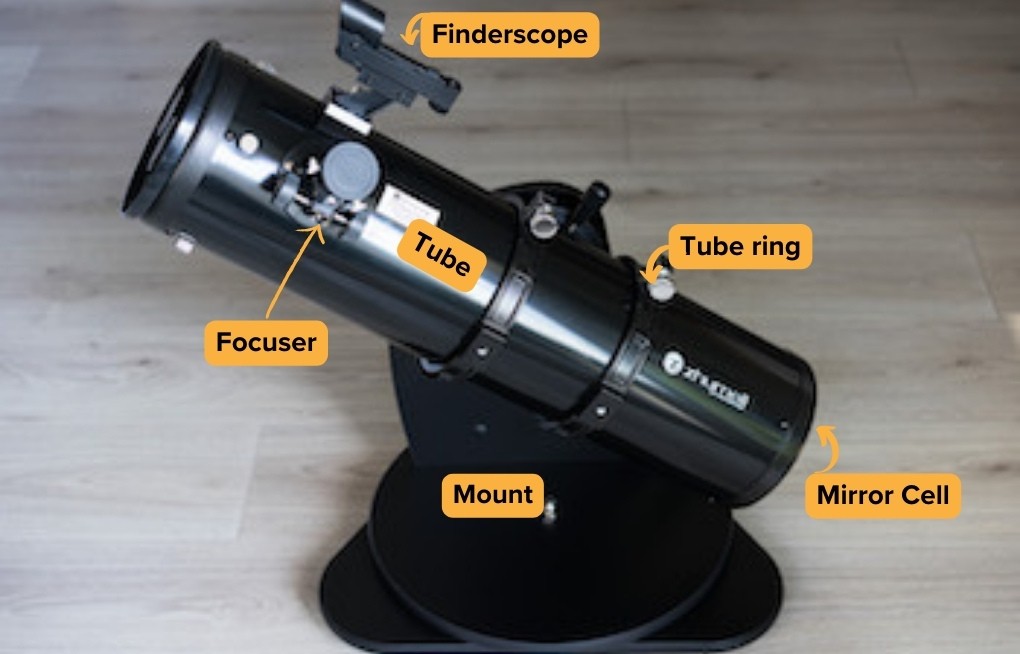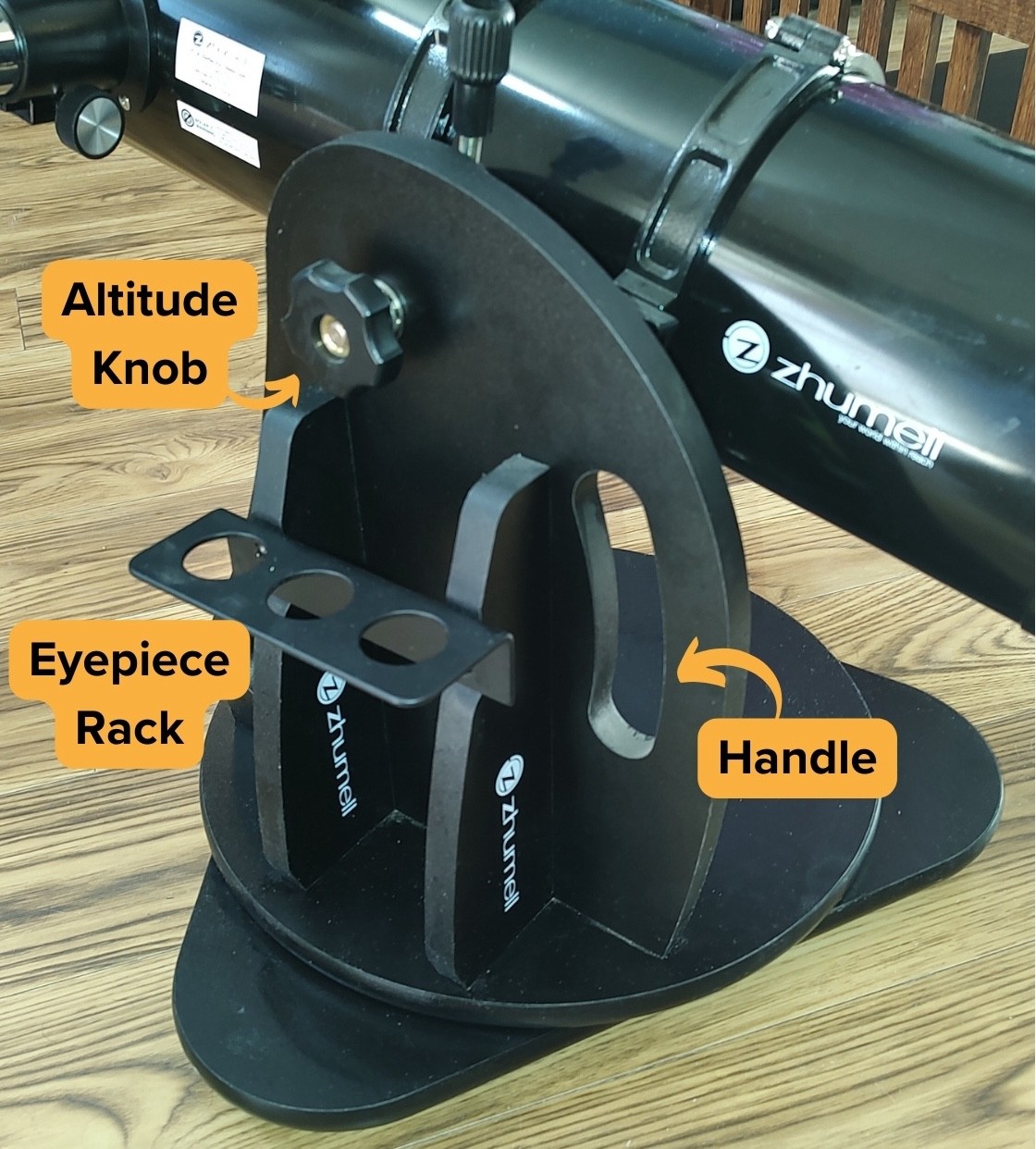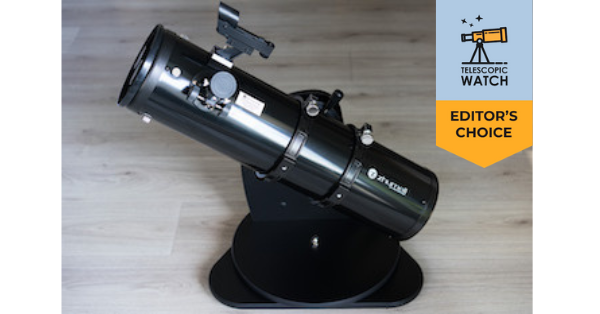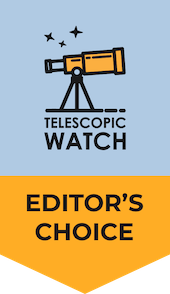Zhumell Z130’s Optical Tube
The Zhumell Z130 is a 130mm f/5 Newtonian reflector with a focal length of 650mm. This optical configuration is fairly common and available from a broad range of brands on a variety of mountings, ranging from tabletop Dobsonians (like the Celestron StarSense 130mm) to equatorial mounts (like the SpaceProbe 130ST) to computerized GoTo rigs (like the NexStar 130SLT).
The Z130, however, is one of the 130mm f/5 variants that, for whatever reason, has a simpler mirror cell similar to the ones I’ve mostly seen on old-fashioned Japanese-made reflectors.

The Zhumell Z130 has the same 1.25” plastic rack-and-pinion focuser found on many beginner scopes, which requires some shimming and lubricant to work well but is perfectly adequate.
The Annoying Optics Collimation
To collimate the Z130, I have to remove a useless metal back plate (purely cosmetic; you can throw it away just like I did) and then adjust 3 pairs of push-pull screws, which tend to easily strip. Both are to be done with screwdrivers.
The good news about this arrangement is that it holds collimation really well, and I didn’t have to adjust it very often.
The bad news is that it requires tools. Stripping the screws in the field may ruin your night if you aren’t near a hardware store that has late hours. Also, learning how to finely adjust the push-pull screws takes a little practice.
Optical Tube’s Ability to Switch Mounts
The Z130’s optical tube attaches to its mount with a pair of tube rings (see above Image 1) and a Vixen-style dovetail.
It’s an arguably overkill arrangement that allows you to not only rotate and slide the tube to balance it or position the eyepiece, but also means you can stick it on almost any other telescope mount with no additional tools or hardware. If, for some reason, you decide you want to use your Z130 on an equatorial or alt-azimuth mount and tripod, this is a huge boon that will save a lot of effort and expense.
Accessories with Z130
Like the other Zhumell tabletops, the Z130 includes two Kellner eyepieces and a red dot finderscope.
In this case of Z130, the eyepieces are a 25mm (26x) and a 10mm (65x), and they are all-metal in construction, albeit lacking rubber eye cups.
At the Z130’s focal ratio of f/5, these eyepieces work pretty well, and I didn’t have too many issues towards the edge of the field of view, though they still suffer from the glare problems inherent in the Kellner design and are a bit uncomfortable to use.
The included red dot finder is, of course, adequate for aiming the Z130 thanks to its wide field of view. It is easy to align and understand how to use it.
The Z130 also comes with an eyepiece rack with 3 slots that screws to the side of the mount, which some people swear by and others despise. I’d say it’s a great way for all of your eyepieces to dew up, but it also makes switching between them a lot more convenient.
There’s no collimation cap included with the Z130, so you’ll have to buy a cap, Cheshire tool, or laser, or you can always make your own collimation cap out of a film canister or cardboard in a few minutes. Check out our collimation guide to learn more about this process and how you can collimate your Z130.
The Tabletop Dobsonian Mount
The Z130 attaches to its tabletop Dobsonian mount with its Vixen-style dovetail and rings.
Like most tabletop scope mounts, the Z130’s mount is technically a single-armed fork and not a “Dobsonian,” but I don’t think there is any need to debate the nomenclature too much.

You can adjust the balance of the tube by either sliding it in its rings (see Image 1) or sliding the whole dovetail plate in the saddle.
For adjusting the friction on the mount, you tighten and loosen the large knob for altitude, while adjusting the friction in azimuth requires two wrenches or pairs of pliers to move the lock nut.
In addition to sporting the eyepiece rack I’ve already mentioned, the Z130’s mount has some cutouts for handles. This helps with carrying the somewhat-heavy scope in one piece.
Tables capable of holding the Z130 tabletop dobsonian in a stable fashion, let alone when using the telescope at high magnifications and tracking targets by hand, are few and far between. The Z130 is also actually somewhat tall to be used on a table, especially while seated. It also wouldn’t be a good idea to put it on a bar stool or the hood of your car. As such, I’d recommend putting it on a milk crate or building a homemade wooden stand.
Should I buy a used Zhumell Z130?
The Z130 is a great scope, and being a relatively new product, not many of them have been able to waste away in neglect, so you’re unlikely to find a used one in poor condition.
A missing base is not a problem in the slightest, as the Z130 can fit on other mounts with its dovetail plate.
Damaged mirror coatings are unfortunately not worth repairing, as recoating the optics costs almost as much as the Z130 itself. Dents to the tube that don’t affect the installation of any hardware can be safely ignored.
Missing eyepieces can also be replaced, though this can get expensive quickly.
Alternative Recommendations
The Z130 is ranked as the top scope in its price range, but there are some alternatives you may want to consider.
- The Sky-Watcher Heritage 130P is essentially a boneless Z130 with a collapsible strut tube instead of a solid metal one. This means it’ll fit in a smaller space and weigh less, but it needs a shroud and will lose collimation more frequently (though collimating it doesn’t require tools). The focuser is also slightly inferior.
- The Sky-Watcher Heritage 150P offers a little more aperture than the Z130 and Sky-Watcher Heritage 130P, albeit at a higher price and with the same compromises as the 130P.
- The various 6” f/8 Dobsonians sold by Orion, Sky-Watcher, and Apertura offer more aperture than the Z130 and don’t require a table, but do have a significantly higher price tag.
Aftermarket Accessory Recommendations
The Z130 is a relatively low-cost scope, so while we’d certainly recommend upgrading accessories, don’t go overboard and push your budget into the next scope price category when you could just simply buy a bigger and better instrument to start with. However, we’d at least recommend a 6mm “gold-line” eyepiece, which will provide 109x with the Z130 – a fairly optimal magnification for the Moon and planets. A 2x Barlow lens will bump it up to 218x with the 6mm gold-line, which is getting to the limit of what the Z130 can handle and may be problematic to track with by hand.
A UHC or ultra-high contrast filter greatly enhances the view of emission nebulae with the Z130, though it does not replace truly dark skies – in fact, a UHC is still useful even with dark skies as the natural sky background is not truly dark anyway.
Better low- and medium-power eyepieces will also enhance your experience with the Z130, but they become costly very quickly.
What can you see with the Zhumell Z130?
The Zhumell Z130 is just at the threshold of being able to give us seriously interesting views of the Moon, planets, and deep-sky objects without being merely a sampler you get tired of.
With the Z130, I could resolve globular clusters like M13 and M22, albeit barely. Under dark skies, the Z130 shows us the spiral arms and dust lanes in bright galaxies like M51, M106, and M33. But keep in mind that without truly dark skies where the Milky Way is obvious overhead, these galaxies are reduced to small fuzzy patches or become completely invisible altogether.
Planetary nebulae also transform from boring patches of light to at least semi-colorful targets with details and personalities of their own, the exception being the comparatively gigantic Ring, Helix, and Dumbbell, which make up for their lack of color or fine detail with their huge angular sizes.
And of course, there’s always the various emission nebulae like Orion and dozens, if not hundreds, of sparkling open clusters, as well as thousands upon thousands of interesting and colorful double and variable stars.
Within the Solar System, the Z130 easily shows the phases of Venus and Mercury and details just a few miles/kilometers across on the Moon. We could spend a lifetime looking at just the Moon and never get tired of it, especially if we wake ourselves up early or stay up late enough to view the less-frequently-enjoyed details when it is waning past full.
Further out, there’s Mars and its ice caps, with any dust storms easily visible as they not only obscure all other detail but transform the planet into a more beige-orange color. Around opposition, a few dark markings on Mars, such as Syrtis Major, can be spotted with ease, and skilled observers like myself can spot its outer moon, Deimos, with lucky timing and by putting Mars and its glare outside the field of view.
Jupiter’s cloud bands look magnificent, with various swirls, festoons, and, of course, the Great Red Spot able to be seen on a steady and clear night. The moons of Jupiter are no longer mere pinpoints but worlds in their own right—albeit tiny disks—and are only clearly distinguishable as such when they transit the planet and cast shadows in their wake.
Saturn’s rings are easy to see with the Z130, as is the gap in the rings known as the Cassini Division. I could also see quite a few moons and some cloud bands on Saturn itself. Uranus is easy to distinguish from a star at high magnification, but its moons are too dim to see, while Neptune is a bit more difficult, and its moon Triton is right on the threshold of being visible with the Z130. Give it a shot, but it’s not guaranteed.




Can you please tell me what lens I should get to see good detail on the planets?
A 6mm redline/goldline eyepiece would be a good start
Bonjour
Je recherche la notice en francais du Zhumell Z 130. Pourriez vous me dire où je pourrais l’avoir ou la télécharger. J’ai acheté ce telescope à mon mari mais il n’y a aucune notice. Merci pour votre renseignement